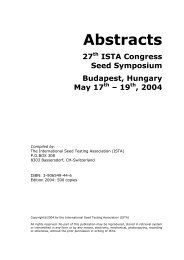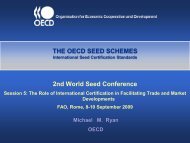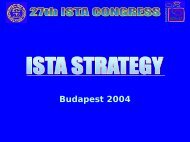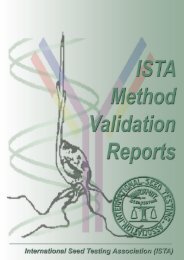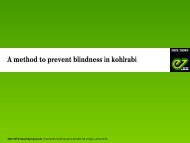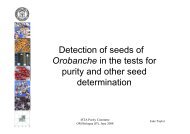Historical Paper - Volume 2 2008 - International Seed Testing ...
Historical Paper - Volume 2 2008 - International Seed Testing ...
Historical Paper - Volume 2 2008 - International Seed Testing ...
You also want an ePaper? Increase the reach of your titles
YUMPU automatically turns print PDFs into web optimized ePapers that Google loves.
H.A. JENSEN<br />
In the report of the Executive Committee of 1950-1953 (Anonymous 1953) it was<br />
mentioned that an agreement was signed between FAO and ISTA on training in seed<br />
technology for persons from developing countries. This lead to development of various<br />
seed programmes, which included workshops and training of staff at new and existing<br />
seed testing laboratories. The seed testing laboratories in e.g. Denmark, France, Germany,<br />
the Netherlands, Norway and United Kingdom have held training courses for seed<br />
analysts from developing countries. The courses were often paid by governmental or other<br />
national and international funds. An updated memorandum of understanding on transfer of<br />
technology and seed quality assurance was signed between ISTA and FAO in 2006.<br />
7. Equipment<br />
7.1 Development of facilities for purity analysis<br />
It has always been of considerable importance to seed analysts to develop facilities suited<br />
for seed testing, and exchange of experience on various kinds of equipment have been on<br />
the agenda for Congresses, Workshops and study visits.<br />
Several titles from the ISTA publications and products catalogue (2005) contain<br />
information of interest in relation to purity analysis and determination of other seeds by<br />
number. Of specific interest are the reports: Project seed laboratory 2000-5000 (Boeke et<br />
al. (1969), van der Burg et al. (1983), van der Burg (1994)); Survey of equipment and<br />
supplies for seed testing (Hardin 1973); Handbook for home made equipment (Madsen<br />
1982).<br />
The ISTA handbook on cleaning of agricultural and horticultural seed on small scale<br />
machines contains a description of the use of laboratory cleaning machines as an aid in<br />
testing for purity and number determination (Madsen and Langkilde 1987, 1988).<br />
The early use of computers for registration of samples and requested analyses,<br />
calculation of purity results, check of tolerances and reporting on ISTA certificates, was<br />
presented at the ISTA Congress in Ottawa 1983 (Lave and Jensen 1983). Computers became<br />
later an important tool in the administration of most of the seed testing laboratories.<br />
7.1.1 Balances<br />
Weighing is important in seed testing, and the seed laboratories have, naturally, followed<br />
the development of suitable balances from mechanical types to the electronic models.<br />
Franck (1928), for example, described and evaluated a quick weighing balance with air<br />
damping and a chainomatic balance from USA.<br />
Electronic balances, sometimes connected with computer systems, are now commonly<br />
used in ISTA seed testing laboratories.<br />
Careful checking of the balances has always been an important element in the ISTA<br />
quality assurance programme in purity laboratories (see 12).<br />
7.1.2 Optical aid<br />
Identification of small seeds and inert materials requires optical aids. All seed laboratories<br />
use hand lenses and magnifying glasses. Use of small magnification glasses may be hard<br />
24



